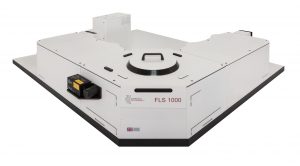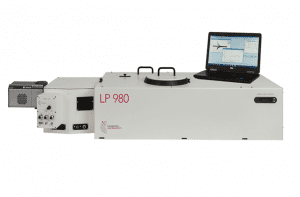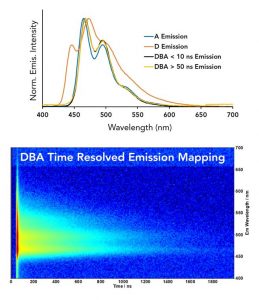Mapping Triplet-to-Singlet Förster-type Intramolecular Energy Transfer Utilising Transient Absorption and Fluorescence Spectroscopy
Introduction
Controlling excited state energetics between molecules to harness and transfer energy is paramount in light-based applications, from photocatalysis to medical imaging to design of next generation organic light-emitting diodes (OLEDs). Triplets state emission (phosphorescence) is a forbidden spin transition, however, statistically 75% of all excited states formed are triplets, which is a tremendous amount of energy lost when trying to make highly efficient devices. Specifically, OLED performance can be drastically improved if triplets can be converted back into highly emissive singlets, especially those that rely on carefully selected excited state energy levels to drive Förster-type energy transfers that are more efficient than thermally activated delayed fluorescence (TADF) and heavy atom systems. To fully optimize such a system, singlet and triplet energy levels, spectra, and lifetimes are of upmost importance; when combined, the Edinburgh Instruments FLS1000 Photoluminescence Spectrometer and the LP980 Transient Absorption Spectrometer provide unparalleled measurements to accomplish next-generation material engineering and device development spanning OLED, solar energy harvesting, medical imaging, and nanotechnology applications.


Figure 1. The Edinburgh Instruments FLS1000 Photoluminescence Spectrometer (top) and LP980 Transient Absorption Spectrometer (bottom).
Research
Featured in the prominent Science Advances journal, this exceptional research into intramolecular Förster-type triplet-to-singlet energy transfer in a donor-bridge-acceptor (DBA) dyad was led by Prof. Karl Börjesson at the University of Gothenburg and team of researchers across Sweden utilising Edinburgh Instruments FLS1000 and LP980 Spectrometers.

Figure 2. The Ir-based donor-bridge-acceptor (DBA) dyad, associated energy levels, and mechanism of the intramolecular Förster-type energy transfer (FRET) from a photogenerated triplet donor to an acceptor excited singlet state.
Figure 2 depicts the molecular DBA dyad and the accompanying Förster-type triplet-to-singlet energy transfer elucidated in this study. Photoexcitation of the Ir-sensitiser donor produces a high yield triplet state in resonant energy of the lowest lying excited singlet state of a bridged perylene acceptor moiety. To encourage the Förster-type triplet-to-singlet energy transfer, the researchers had three design criteria: (i) donor triplet emission should be resonant with acceptor absorption, (ii) the bridging unit should not be conjugated to minimize electron tunnelling, and (iii) the bridge should not allow for bending or folding of the molecular dyad to avoid acceptor and donor contact. The ingenuity of such a DBA dyad is clearly evident in this research, finding a perfect pair of molecules to link to observe Förster-type triplet-to-singlet energy transfer, and prove the mechanism using steady state and time resolved emission as well as nanosecond transient absorption.

Figure 3. (Top) Steady state emission spectra of the donor (D) and acceptor (A) overlaid with the time-resolved emission spectra of the DBA a multiple delay times generated from time-resolved emission spectroscopy mapping (Bottom).
Figure 3 shows the steady state emission of the donor and acceptor, as well as the time-resolved emission spectra of the DBA dyad collected gleaned from utilising automated time-resolving emission mapping recorded on an Edinburgh Instruments FLS1000. Comparing the time-resolved emission spectra of DBA to the steady state emission of the donor and acceptor, it is clear all of the emission arises from the acceptor over a much longer time scale than the native 3.1 ns emission lifetime of just the acceptor. Measuring the lifetimes and quantum yields of the donor, acceptor, and dyad yielded spectra and rate constants consistent with Förster-type triplet-to-singlet energy transfer, with a rate more than 36 times faster than the donor phosphorescence.
Figure 4. (Top) Time-gated transient absorption spectra recorded on an ICCD detector and (bottom) lifetime traces at recorded by a PMT detector of the DBA complex highlighting the long lifetime of the acceptor band at 485 nm.
To fully describe the mechanisms involved, specifically non-radiative decay, transient absorption was employed to measure the spectra and lifetimes of the donor and DBA complex; this provided insight into the triplet-triplet energy transfer rate that supports their proposed mechanism.
Conclusion
Steady state and time resolved emission spectroscopy, coupled with transient absorption spectroscopy provided by Edinburgh Instruments FLS1000 and LP980 Spectrometers, were utilised to show Förster-type triplet-to-singlet energy transfer for the first time in a well-designed donor-bridge-acceptor molecular system that could be paramount to designing new, highly efficient OLED materials.
Link to Article: https://advances.sciencemag.org/content/5/9/eaaw5978
Figures reprinted with permission from Sci. Adv., 2019; 5: eaaw5978.
The FLS1000 Photoluminescence Spectrometer and The LP980 Transient Absorption Spectrometer
An Edinburgh Instruments FLS1000 Photoluminescence Spectrometer and an LP980 Transient Absorption Spectrometer were used in this research. Find out more about these products on our website.
Stay in touch
If you have enjoyed this research highlight and would like to be the first to know about out future application notes, blog posts and news stories, please take a moment to join us on social media and sign up to our infrequent eNewsletter via the link below.








